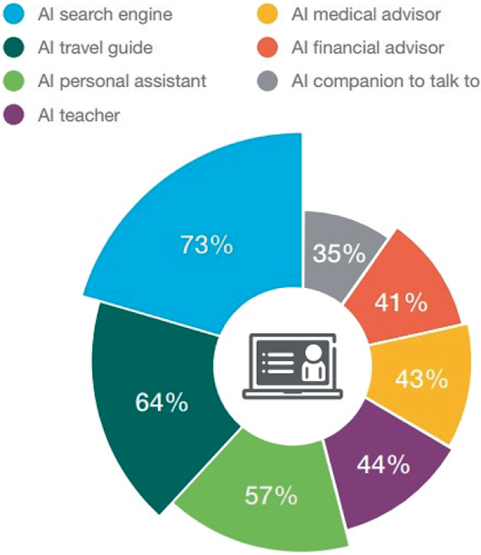AI in Cognitive Behavioral Therapy
According to the World Health Organization, there is a global shortage of mental health-trained health workers. Many mental health initiatives do not reach those in need, with nearly 70% having no access to these services. In 2017, 42.6% of adults with mental illnesses in the United States received mental health services. In particular, 75% of patients with depression in primary care settings have one or more structural or psychological barriers that prevent them from receiving behavioral treatments. To address these issues, Kazdin and Rabbitt proposed new models of psychosocial intervention delivery. According to Mohr et al., behavioral intervention technologies (BITs) may offer a potential solution to resolve barriers to access and expand mental health care.
Behavioral intervention technology
Behavioral Intervention Technology (BIT) includes using
technology features that address behavioral, cognitive, and affective
components that support physical, behavioral, and mental health to implement behavioral
and psychological intervention strategies. Internet interventions for anxiety
and depression have factual support with outcomes equivalent to
therapist-delivered cognitive behavioral therapy (CBT). Several BITs use the
same content as face-to-face CBT programs, allowing them to reach a larger
population at a lower cost.
Chatbots are BITs that are used in addressing mental health
conditions. Chatbots are software programs that perform text-based or
voice-activated conversations with users and respond to them using
preprogrammed responses or artificial intelligence (AI). Woebot, Shim, KokoBot,
Wysa, Vivibot, Pocket Skills, and Tess are some of the most reported mental
health chatbots in the literature.
Artificial intelligence in CBT
Scott et al. (2015) conducted a systematic review of studies
of pure Technology-based CBT (TB-CBT) intervention for dementia carers dating
back to 1995. The databases Cochrane Reviews, PsycINFO, MedLine, and Scopus,
were searched using keywords related to CBT, carers, and dementia. They
identified 440 articles, and inclusion/exclusion criteria were applied; only
studies with quantitative data available and no active therapist contact were
retained. Two randomized trials and two waitlist control trials were chosen.
Quality of methodology and reportings were evaluated. For the outcome measures
of caregiver depression, meta-analyses were performed. The meta-analysis found
that pure TB-CBT interventions for depression had small but significant
post-intervention effects, similar to face-to-face interventions. There is,
however, no evidence of the long-term efficacy of pure TB-CBT for dementia
carers. The systematic review also identified critical methodological and
reporting flaws in these studies.
Another study was conducted by Fitzpatrick et al. in 2017.
The study was designed to find the feasibility, acceptability, and preliminary
efficacy of an entirely automated conversational agent in delivering a
self-help program to college students who self-identify as experiencing
symptoms of anxiety and depression. In this unblinded trial, 70 participants
between the ages of 18 and 28, with an average age of 22.2 years old (SD 2.33),
67% female (47/70), Caucasian (79%, 46/58), and non-Hispanic (93%, 54/58) were
recruited online from a university community social media site and were
randomly allocated to either two weeks (up to 20 sessions) of self-help content
derived from CBT principles in a text-based conversational agent (Woebot)
(n=34) or the ebook "Depression in College Students" by the National
Institute of Mental Health (NIMH) as an information-only control group (n=36).
At baseline and 2-3 weeks later, all participants have
completed Web-based versions of the 7-item Generalized Anxiety Disorder scale
(GAD-7), the 9-item Patient Health Questionnaire (PHQ-9), and the Positive and
Negative Affect Scale (T2). Interaction of participants in the Woebot group
with the conversational agent was observed at an average of 12.14 (SD 2.23)
times throughout the study. There was no notable difference between the groups
at baseline, and 83% (58/70) of participants provided data at 17% attrition
(T2).
Aims to treat univariate covariance analysis showed a
significant group difference in depression, with those in the Woebot group
greatly reducing their depressive symptoms as measured by the PHQ-9 over the
study period (F=6.47; P=.01). However, the participants in the information
control group did not. As measured by the GAD-7 (F1,54= 9.24; P=.004),
observation showed that both groups significantly reduced anxiety. According to
the comments of those who completed the study successfully, process factors
were more influential on their acceptance of the program than content factors
similar to traditional therapy.
Åho et al. proposed a paper on Virtual Reality (VR) based
treatment for Social Anxiety Disorder and speech anxiety using CBT. CBT is the
most widely used psychological treatment for Social Anxiety Disorder (SAD) and
speech anxiety. The core principle of graduated exposure to a feared phenomenon
is effectively reducing stress and anxiety symptoms. A fundamental principle of
exposure-based therapy is that the exposure should trigger an emotional and
physiological response. It is built on the concept that an effective
VR-enhanced CBT (VR-CBT) treatment should cause physiological responses like
elevated heart rate and skin conductance. Several studies indicate that
VR-based therapy can produce such responses.
To summarize, VR technology appears to recreate phobic
situations with sufficient accuracy to evoke fear responses similar to
real-world situations. A program that promotes inhibitory learning by
disproving catastrophic beliefs. It should be conducted by exposing patients to
distressing speech situations in virtual reality environments. The concept also
aims at self-attention and biased recall by mental imagery-enhanced audio
feedback. The paper also suggests treatment prediction based on the brain data
collected, using AI for new treatment strategies. According to research, VR-CBT
appears to be effective in improving the quality of life by reducing depression
and anxiety.
Looking forward
AI-based programs like chatbots appear to be feasible,
engaging, and effective methods of delivering CBT. These programs effectively
reduced depression and anxiety. However, to understand better how AI-based
information could strengthen CBT, researchers should focus on how much trust or
confidence individuals undergoing treatment can have in information derived
from AI applications. If AI-derived information is trusted to the same extent
as traditional information from psychologists, potential doors may unlock for
CBT design.
References
Åhs, F., Mozelius, P., & Dobslaw, F. (2020). Artificial
Intelligence Supported Cognitive Behavioral Therapy for Treatment of Speech
Anxiety in Virtual Reality Environments. In ECIAIR 2020 (Vol. 2). Academic
Conferences and Publishing International Limited.
Dosovitsky, G., Pineda, B. S., Jacobson, N. C., Chang, C.,
& Bunge, E. L. (2020). Artificial intelligence chatbot for depression:
Descriptive study of usage. JMIR Formative Research, 4(11), e17065.
Fitzpatrick, K. K., Darcy, A., & Vierhile, M. (2017).
Delivering cognitive behavior therapy to young adults with symptoms of depression
and anxiety using a fully automated conversational agent (Woebot): a randomized
controlled trial. JMIR mental health, 4(2), e7785.
Kazdin, A. E., & Rabbitt, S. M. (2013). Novel models for
delivering mental health services and reducing the burdens of mental illness.
Clinical Psychological Science, 1(2), 170-191.
Mohr, D. C., Burns, M. N., Schueller, S. M., Clarke, G.,
& Klinkman, M. (2013). Behavioral intervention technologies: evidence
review and recommendations for future research in mental health. General
hospital psychiatry, 35(4), 332-338.
Scott, J. L., Dawkins, S., Quinn, M. G., Sanderson, K.,
Elliott, K. E. J., Stirling, C., ... & Robinson, A. (2016). Caring for the
carer: a systematic review of pure technology-based cognitive behavioral
therapy (TB-CBT) interventions for dementia carers. Aging & mental health,
20(8), 793-803.






.jpg)



No comments